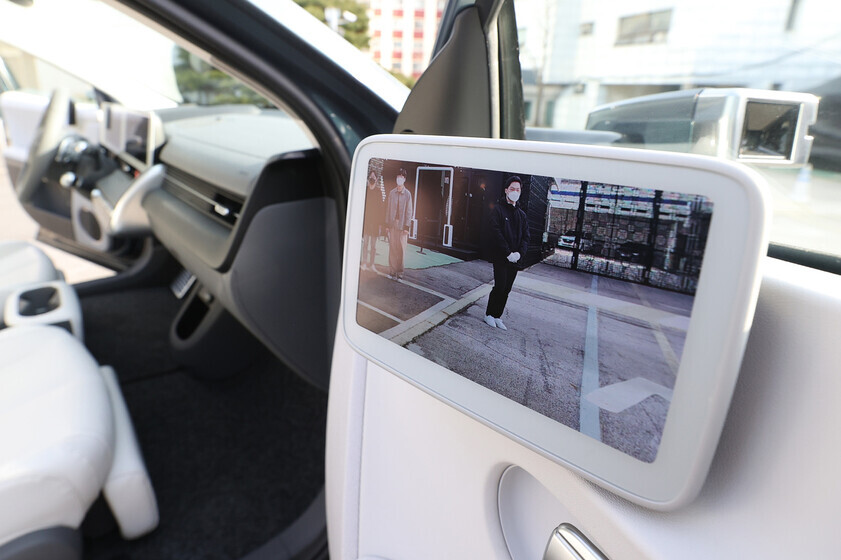hankyoreh
Links to other country sites 다른 나라 사이트 링크
Samsung moves into market for car image sensors

As we move toward the cars of the future, all eyes are on “vehicle eyes” — the automotive sensors used in around view monitoring and digital side mirrors. The top two companies in the image sensor industry, which have previously focused on making the sensors used in smartphone cameras, are now barreling into the automotive sensor sector.
Samsung Electronics announced Wednesday that it’s fully expanding into the automotive image sensor sector and releasing the ISOCELL Auto 4AC as its first product in that area. This sensor will be supplied to a vehicle by a global automaker brand that’s set to be released in the second half of the year.
The ISOCELL Auto 4AC is the first product in the ISOCELL Auto brand of automotive image sensors, which Samsung launched three years ago in 2018. The sensor will be used in around view monitoring and backup cameras.
Image sensors are system semiconductors whose function is to convert light — that is, image data — that enters the camera lens into a digital signal. For more than twenty years, Samsung has only made mobile image sensors, which determine the performance of smartphone cameras.
As of 2020, Samsung is the second biggest player in the image sensor market, with a 19.8% share of sales, but it doesn’t have a presence in the automotive image sensor market.
The major players in the automotive image sensor market are the US’ ON Semiconductor (38.3% by volume), which acquired Aptina Imaging in 2014; China’s OmniVision Technologies (18.8%); and Japan’s Sony (9.7%).
Samsung appears to be expanding its lineup of image sensors because of the high growth potential in the automotive image sensor market, given the boom in technology for autonomous vehicles.
In a report published in December 2020, Techno Systems Research (TSR), a market research firm, projected that the automotive image sensor market will see very steep growth. TSR expects the market to grow by a yearly average of 11% over the next four years, through 2024 — a phenomenal level of growth, considering the image sensor market as a whole is projected to post 6.8% of yearly growth in the same period.
Automotive image sensors require higher performance and safety standards than mobile sensors do because of their potential impact on car accidents, and therefore on human lives.
Another difference between the two is durability; automotive image sensors need to hold up for at least five years. Automobiles stay in use much longer than smartphones, which tend to be replaced every two years.
Such issues make it necessary to work closely with car companies from the initial planning stage, which is why Samsung says it takes longer to develop image sensors for cars than it does for mobile devices. But Samsung hasn’t disclosed which automaker is its partner.
“We plan to expand our automotive sensor lineup to areas such as camera monitor systems, autonomous driving and in-cabin monitoring,” said Chang Duck-hyun, executive vice president of Samsung’s sensor division.
By Sun Dam-eun, staff reporter
Please direct comments or questions to [english@hani.co.kr]

Editorial・opinion
![[Column] Welcome to the president’s pity party [Column] Welcome to the president’s pity party](https://flexible.img.hani.co.kr/flexible/normal/500/300/imgdb/original/2024/0515/3917157400447943.jpg) [Column] Welcome to the president’s pity party
[Column] Welcome to the president’s pity party![[Editorial] Korea must respond firmly to Japan’s attempt to usurp Line [Editorial] Korea must respond firmly to Japan’s attempt to usurp Line](https://flexible.img.hani.co.kr/flexible/normal/500/300/imgdb/original/2024/0514/2317156736305813.jpg) [Editorial] Korea must respond firmly to Japan’s attempt to usurp Line
[Editorial] Korea must respond firmly to Japan’s attempt to usurp Line- [Editorial] Transfers of prosecutors investigating Korea’s first lady send chilling message
- [Column] Will Seoul’s ties with Moscow really recover on their own?
- [Column] Samsung’s ‘lost decade’ and Lee Jae-yong’s mismatched chopsticks
- [Correspondent’s column] The real reason the US is worried about Chinese ‘overcapacity’
- [Editorial] Yoon’s gesture at communication only highlights his reluctance to change
- [Editorial] Perilous stakes of Trump’s rhetoric around US troop pullout from Korea
- [Guest essay] Preventing Korean Peninsula from becoming front line of new cold war
- [Column] The state is back — but is it in business?
Most viewed articles
- 1[Column] Welcome to the president’s pity party
- 2Could Korea’s Naver lose control of Line to Japan?
- 3US has always pulled troops from Korea unilaterally — is Yoon prepared for it to happen again?
- 4[Editorial] Transfers of prosecutors investigating Korea’s first lady send chilling message
- 5[Column] Will Seoul’s ties with Moscow really recover on their own?
- 6Major personnel shuffle reassigns prosecutors leading investigations into Korea’s first lady
- 7Naver’s union calls for action from government over possible Japanese buyout of Line
- 8[Correspondent’s column] The real reason the US is worried about Chinese ‘overcapacity’
- 9[Editorial] Korea must respond firmly to Japan’s attempt to usurp Line
- 10Number of foreign residents in S. Korea triples over ten years